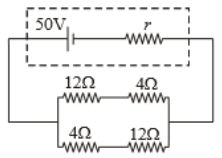Two sources of equal emf are connected to an external resistance R. The internal resistances of the two sources are R1 and . If the potential difference across the source having internal resistance R2 is zero, then
(1)
(2)
(3)
(4)
समान विद्युत वाहक बल के दो स्रोत एक बाह्य प्रतिरोध R से जुड़े हैं। दोनों स्रोतों के आंतरिक प्रतिरोध R1 और है। यदि R2 आंतरिक प्रतिरोध वाले स्रोत का विभवांतर शून्य हो, तब-
(1)
(2)
(3)
(4)
If the voltage across a bulb decreases by 1%, then the percentage change in its power output is :
| 1. | 1% | 2. | 4% |
| 3. | 2% | 4. | 5% |
यदि किसी बल्ब में वोल्टता 1% घट जाती है, तब इसकी निर्गत शक्ति में प्रतिशत परिवर्तन कितना है?
| 1. | 1% | 2. | 4% |
| 3. | 2% |
4. | 5% |
In the circuit shown in figure find the value of r(internal resistance of the cell) for which power transferred by the cell is maximum

1.
2.
3.
4.
आरेख में दर्शाए गए परिपथ में r (सेल का आंतरिक प्रतिरोध) का मान ज्ञात कीजिए जिसके लिए सेल द्वारा दी गयी शक्ति अधिकतम है-

1.
2.
3.
4.
A resistance of 4 Ω and a wire of length 5 metres and resistance 5 Ω are joined in series and connected to a cell of e.m.f. 10 V and internal resistance 1 Ω. A parallel combination of two identical cells is balanced across 300 cm of the wire. The e.m.f. E of each cell is
(1) 1.5 V
(2) 3.0 V
(3) 0.67 V
(4) 1.33 V
4 Ω का एक प्रतिरोध और 5 मीटर लंबाई तथा 5 Ω प्रतिरोध का एक तार श्रेणीक्रम में 10 V विद्युत वाहक बल और 1 Ω आंतरिक प्रतिरोध के सेल से जुड़े हुए है। दो समान सेलो का समांतर क्रम संयोजन तार के 300 cm पर संतुलित होता है। प्रत्येक सेल के विद्युत वाहक बल की गणना कीजिए -
(1) 1.5 V
(2) 3.0 V
(3) 0.67V
(4) 1.33V
In the arrangement of resistances shown below, the effective resistance between points A and B is
(1) 20 Ω
(2) 30 Ω
(3) 90 Ω
(4) 110 Ω
निम्नवत् दर्शाई गई प्रतिरोधों की व्यवस्था में, बिंदुओं A और B के मध्य प्रभावी प्रतिरोध की गणना कीजिए-
(1) 20 Ω
(2) 30 Ω
(3) 90 Ω
(4) 110 Ω
Eels are able to generate current with biological cells called electroplaques. The electroplaques in an eel are arranged in 100 rows, each row stretching horizontally along the body of the fish containing 5000 electroplaques. The arrangement is suggestively shown below. Each electroplaques has an emf of 0.15 V and internal resistance of 0.25 Ω
The water surrounding the eel completes a circuit between the head and its tail. If the water surrounding it has a resistance of 500 Ω, the current an eel can produce in water is about
(1) 1.5 A
(2) 3.0 A
(3) 15 A
(4) 30 A
ईल, इलेक्ट्रोप्लाक्स नामक जैविक कोशिकाओं से धारा उत्पन्न करने में सक्षम होते हैं। एक ईल में इलेक्ट्रोप्लाक 100 पंक्तियों में व्यवस्थित होते हैं, 5000 इलेक्ट्रोप्लाक युक्त प्रत्येक पंक्ति मछली की काया के अनुदिश क्षैतिज रूप से तनित होती है। व्यवस्था को सांकेतिक रूप से नीचे दर्शाया गया है। प्रत्येक इलेक्ट्रोप्लाक में 0.15V का विद्युत वाहक बल होता है और 0.25 Ω का आंतरिक प्रतिरोध होती है।
*5000 electroplaques per row - 5000 इलेक्ट्रोप्लाक्स प्रति पंक्ति
ईल के चारों ओर का जल, सिर और पूँछ के मध्य परिपथ को पूर्ण करता है। यदि इसके चारों ओर का प्रतिरोध 500Ω हो, जल में एक ईल द्वारा उत्पन्न की जाने वाली धारा की गणना कीजिए -
(1) 1.5 A
(2) 3.0 A
(3) 15 A
(4) 30 A
If each resistance in the figure is of 9 Ω, then reading of ammeter is
(1) 5 A
(2) 8 A
(3) 2 A
(4) 9 A
यदि दिए गए आरेख में प्रत्येक प्रतिरोध 9 Ω का है, तब ऐमीटर का पाठ्यांक ज्ञात कीजिए।
(1) 5 A
(2) 8 A
(3) 2 A
(4) 9 A
The equivalent resistance of resistors connected in series is always :
(1) Equal to the mean of component resistors
(2) Less than the lowest of component resistors
(3) In between the lowest and the highest of component resistors
(4) Equal to the sum of component resistors
श्रेणीक्रम में जुड़े प्रतिरोधकों का समतुल्य प्रतिरोध हमेशा कैसा होता है?
(1) घटक प्रतिरोधों के माध्य के बराबर
(2) घटक प्रतिरोधों के न्यूनतम की तुलना में कम
(3) घटक प्रतिरोधों के अधिकतम और न्यूनतम के बीच
(4) घटक प्रतिरोधों के योग के बराबर
Two wires of same metal have the same length but their cross-sections are in the ratio 3 : 1. They are joined in series. The resistance of the thicker wire is 10 Ω. The total resistance of the combination will be
(1) 40 Ω
(2)
(3)
(4) 100 Ω
एक ही धातु के तारों की लंबाईयाँ समान है, परन्तु इनके अनुप्रस्थ काट के क्षेत्रफलों का अनुपात 3 : 1 है। इन्हें श्रेणी क्रम में जोड़ा गया है। मोटे तार का प्रतिरोध 10 Ω है। संयोजन का कुल प्रतिरोध कितना होगा?
(1) 40 Ω
(2)
(3)
(4) 100 Ω
A current of 2A flows through a 2 resistor
when connected across a battery. The same
battery supplies a current of 0.5 A when
connected across a 9 resistor. The internal
resistance of the battery is
(a) (b)
(c) (d)
2A की एक धारा 2 प्रतिरोध से होकर बहती है जब यह एक बैटरी से जुड़ा है। समान बैटरी 0.5 A की धारा आपूर्ति करती है जब 9 के प्रतिरोध से जुड़ी होती है। बैटरी का आतंरिक प्रतिरोध है:
(a) (b)
(c) (d) 0.5Ω














